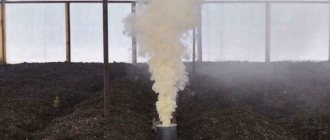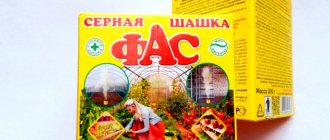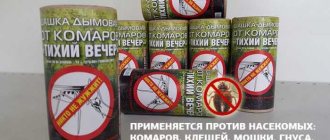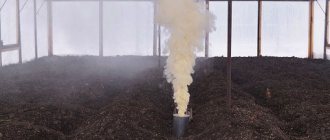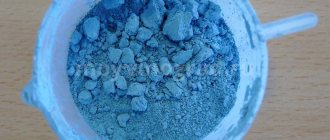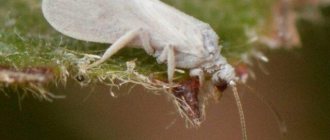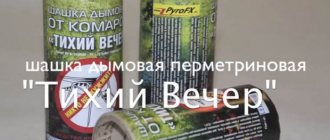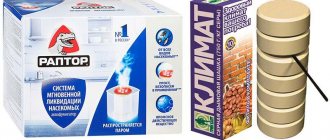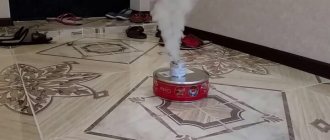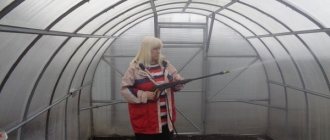Plants in closed ground are susceptible to many diseases and pest attacks. Annual disinfection of the greenhouse using a sulfur bomb will help to avoid this. This method of disinfection allows you to get rid of diseases and insects in one or two procedures.
The technology for fumigating greenhouses with smoke bombs is quite simple, but for it to be effective and safe, the instructions must be strictly followed.
Sulfur block for polycarbonate greenhouse
The benefits and harms of sulfur bombs for polycarbonate greenhouses
Treating greenhouses with smoke often gives a more noticeable effect than using various drugs or folk remedies. Sulfur gas, circulated during combustion, penetrates well into the soil and hard-to-reach corners, destroying a wide variety of pests. The use of sulfur bombs provides several advantages:
- The product is versatile. It allows you to completely destroy almost all common insect pests, as well as fungi, bacteria and viruses.
- The processing is quite simple, even a novice amateur can handle it.
- Minimal labor costs: no need to dilute the solution, walk next to the bushes and spray them. It is enough to set fire to a few pieces and immediately leave the greenhouse.
- Affordability – checkers, as a rule, are cheaper than even the most common drugs. In addition, they replace both insecticides and fungicides.
However, this tool also has several disadvantages:
- Care must be taken to observe safety precautions and observe the emission of smoke for fire safety purposes. Sulfur dioxide in high concentrations can be harmful to health.
- The gas released during combustion has a bad effect on metal structures. Therefore, they must first be treated with a primer or grease.
It is important to understand that fumigating a greenhouse with a sulfur bomb is allowed in the fall and spring, when there are no plants in it. Burning during other periods (summer) is dangerous for seedlings. If at this point there are problems with insects and other pests, insecticides, fungicides and folk remedies should be used.
Sulfur powder is ignited from the wick
Reviews
Agrovit "Fas"
Maxim: “Fas” is good for disinfecting greenhouses and cellars: it destroys rot and insects. For example, the house is old, built in the 50s of the last century. There is a bug in the wooden components. The creature is harmful. At first, the owners covered the wood with drying oil, but such protection did not last long. We decided to use the Fas smoke bomb. This is a cylinder containing gypsum and sulfur. Can be cut into pieces.
The wood was processed. The bugs are gone. Rot and mold also disappeared, and with them rodents: mice, rats. The drug can be used to treat basements, garages, and greenhouses.
Disadvantage: highly flammable, toxic. One sip can cause serious poisoning. But, if you follow the safety rules specified in the instructions, the product is completely harmless.
Green Belt "Climate"
Oleg: A smoke bomb is used against diseases and various plant pests in greenhouses, cellars, and greenhouses.
The downside is that it is difficult to light the wick. Checker set - wick, pyramid of ten sulfur tablets. One pyramid is enough to disinfect 20 cubic meters of a greenhouse.
The wick burns for 2 minutes. But it smokes effectively for almost 15 minutes. The result exceeds expectations - mold disappears, and so do harmful insects. The smoke is acrid, poisonous.
Operating principle
The composition of the sulfur bomb contains dry substances, and the active substance is sulfur (in dry powder form) in an amount of 750-800 g per 1 kg of mixture. When burned, it combines with oxygen and forms sulfur dioxide SO2, which completely destroys various plant pests:
- insects;
- viruses;
- bacteria;
- fungi.
This substance also repels rats, mice and other rodents.
The combustion process is slow, without the formation of an open flame. After the protective surface (packaging lid) burns, the powder begins to smolder, releasing abundant, thick smoke of a dark yellow, brownish color. Thanks to the closed space, massive death of insects and other pests is observed already on the day of treatment.
The principle of operation of the checker is based on the destruction of pests by smoke generated by the combustion of sulfur. Important! The sulfur gas released during combustion actively absorbs moisture from the air, which makes it possible to cope with mold and rot.
Today you can purchase several types of sulfur bombs. They differ in the amount of active ingredient and packaging (different weights). Therefore, during the application process, you need to correctly calculate the amount based on the fact that 300 g is enough for every 5 m3 of the greenhouse.
The most famous are:
- FAS;
- Climate.
The FAS sulfur block for a polycarbonate greenhouse has a high sulfur concentration - 800 g of dry matter per 1 kg of mixture. Copes well with pathogenic bacteria, fungi, rot, mold and insect pests. It dehumidifies the air, making it suitable not only for treating greenhouses, but also for storing vegetables (basements, cellars, storage rooms).
The product is sold in briquettes of 300 g. They should be stored in a dry place at room temperature. Shelf life is 5 years if storage conditions are met.
FAS sulfur bomb is used for combustion in greenhouse structures, basements and cellars
In accordance with the instructions, the sulfur smoke bomb Climate for a greenhouse is used to treat any utility premises. The sulfur concentration is 750 g per 1 kg of mixture. The product is sold in briquettes of 300 g, 40 pieces are packed in one box.
Consumption depends on the type of room:
- For empty greenhouses, greenhouses and greenhouses, 300 g per 20 m3 is sufficient.
- For empty basements, cellars, storages – 300 g per 10 m3.
Important! After treatment, it is recommended to ventilate greenhouses for 8-10 days in a row, and basements for at least two days.
Checkers are packaged in 300 g pieces - this amount is enough for 10-20 m3 of space
Description of the product and principle of its action
A smoke bomb visually represents a package weighing 300 grams. It is usually collected from 5-10 tablets, which are enough to treat a room with a volume of up to 20 cubic meters.
Smoke bombs are filled with various chemicals. The most common ones are:
- sulfur;
- permethrin;
- tobacco dust;
- hexachlorane;
- didecyldimethylammonium.
Most often, sulfur and tobacco bombs are produced, which will be discussed. In the first model, the active substance is sulfur, which belongs to the second hazard class and is toxic to people, birds and bees. It is prohibited to set it on fire in the basement under a residential building or under the floor.
The industry produces several types of such checkers, but their operating principle is the same. After igniting the fuse, the combustion process begins, during which the checker emits sulfur dioxide. It is lighter than air, and therefore completely fills the smallest cracks and crevices, having a detrimental effect on pathogenic microbes and insects.
This is interesting: smoke bombs are divided into universal (they get rid of mold and parasites) and specialized (against moles, rodents and insects).
Instructions on how to use a sulfur bomb in a greenhouse
The rules for using checkers are quite simple. It does not give off an open flame, so it does not pose a particular fire hazard. A sulfur bomb is used against spider mites and other pests in a greenhouse according to the following instructions:
- Preparatory stage - it is necessary to remove all metal objects, preparations (cans), collected fruits and vegetables from the premises. If any metal products remain, they need to be coated with grease or other lubricant.
- Seal the holes, seal small cracks on the outside with tape.
- Thoroughly loosen the ground so that the smoke penetrates as deeply as possible into the soil and destroys insects in various forms (eggs, larvae).
- Calculate the required number of sulfur bombs and arrange them evenly over the entire area of the greenhouse. The surface must be fireproof, because during combustion the checker becomes very hot. It is optimal to place them on bricks.
- Put on a respirator mask, safety glasses, carefully gather all your hair into a bun and throw it over your back.
- Quickly light the wicks and immediately leave the greenhouse, tightly closing the door from the outside. It is better to ignite it in the open air so that the flame flares up better. The saber must be carried at arm's length, without touching clothing or the body.
- Using a sulfur bomb in a polycarbonate greenhouse is a rather lengthy process. Combustion lasts 1-1.5 hours, but after this the greenhouse is kept closed for at least a day. During this time, you can only enter the greenhouse if absolutely necessary, and it is advisable to wear a mask and goggles (for swimming).
- Then thoroughly ventilate for another two days and close the door. Seedlings can be planted after 1 week.
Important! If you burn a checker in a cellar or basement, you can put vegetables there no earlier than 5 days after the end of ventilation.
During processing, it is best to place the sulfur bomb on bricks
How many sulfur bombs are needed for a greenhouse?
The rate of treatment of a greenhouse with a sulfur bomb depends on the specific preparation. Basically, the concentration of the active substance (sulfur) is approximately the same - 750-800 g per 1 kg of mixture. Therefore, the following consumption rules have been established:
- when processing greenhouses, hotbeds and greenhouses 60 g/m3;
- when processing cellars and basements for storage 30-60 g/m3.
Accordingly, to process every 5 m3 of a greenhouse, you will need 1 sulfur block of a standard weight of 300 g. For example, if you take a standard greenhouse 3 m wide, 6 m long and 2 m high, the volume will be 3 * 12 * 2 = 72 m3. To process such a volume, you need to take 72/5 = 14 sulfur bombs.
Instructions for use
Before setting fire, you need to water all the surfaces of the greenhouse so that the “smoke” will smolder longer. It is most convenient to use a hose. After that:
- Place the tablets evenly on stands around the perimeter of the greenhouse. You can place the entire workpiece in the center of the room.
- Light the fuse. In conditions of high humidity it may burn poorly. Some summer residents advise using a little kerosene for ignition, but in no case gasoline.
- As soon as you see that a fire has appeared, immediately leave the greenhouse and close the door tightly. The wick burns for approximately 1.5-2 minutes.
The checker will smolder for several hours. But you can’t open the greenhouse right away! For better disinfection, leave it sealed for another 2-3 days. After this, ventilate the greenhouse for several days.
There is no need to wash the greenhouse after burning the sulfur bomb. Better take care of soil fertility, which can be degraded by toxins. After fumigation, fertilize the soil and treat it with preparations containing beneficial bacteria.
When to treat a greenhouse with a sulfur bomb
It is best to apply the treatment in early autumn. Also in some situations, a spring procedure is allowed. But this product cannot be used in the summer - there should be no plants in the greenhouse.
When to treat a greenhouse with a sulfur bomb in the spring
In the spring, burning checkers is necessary only in 2 cases:
- For some reason, the procedure was not carried out last fall.
- The pest invasion was very large; many bushes suffered from fungi and other pathogens.
It should be noted that in the spring, the treatment of the greenhouse with a sulfur bomb is carried out only in April or even in May, when the soil has warmed up to at least 10 degrees Celsius.
Sulfur bomb in a greenhouse in autumn
Autumn is the optimal time for burning sulfur bombs in a greenhouse. You can start the procedure immediately after harvesting. The area is cleared, all flammable materials, liquids and objects are removed, and then several bombs are set on fire according to the instructions. Repeated treatment is carried out only in cases where there was a severe insect infestation in the summer. This can be done after 1-2 days.
Particular attention should be paid to the air temperature. It is better to treat the greenhouse with a sulfur bomb in early autumn, when the daytime temperature is consistently above 10-15 degrees. The fact is that if it is cool outside or even freezing, sulfuric acid will begin to form as a by-product. It is well absorbed by the soil and can impair fertility.
The optimal period for processing the greenhouse is the second half of September
Types of smoke bombs
Which sulfur bomb should I choose for processing a polycarbonate greenhouse? This question worries many novice summer residents. Often, sulfur bombs are mistakenly classified as means for killing insects and microorganisms based on other toxic substances. The scope of application of the smoke bomb and its effectiveness depend on the active substance.
Table 1. Types of smoke bombs.
| Type of smoke bomb | Description |
| Checkers FAS, Climate, Pawn | Sulfur-based checkers are used to get rid of fungal and bacterial infections, mold, and rot. They are also effective against insect pests: spider mites, aphids, thrips, whiteflies, leaf-eating caterpillars, slugs. It inhibits plants; treatment is carried out only in an empty greenhouse after complete harvesting of the crop and plants. |
| Checkers G-17, G-20 | Smoke bombs based on hexachlorane, a systemic insecticide with contact-intestinal action. Effective against aphids, caterpillars, thrips and whiteflies. They have no noticeable effect on herbivorous mites. They are also useless against diseases. Use during the growing season is not allowed. |
| Checker Whist | Checkers with didecyl-dimethyl-ammonium bromide have a pronounced fungicidal and bactericidal effect, and also kill insect pests. Checkers with bromide effectively fight wet rot and fungal infections. It is allowed to use the checker in the first weeks of the plant growing season, even before the start of fruiting. |
| Checkers City, Quiet Evening, Tsifum | Checkers based on permethrin have a wide range of effects on insect pests. Effective against all types of aphids, caterpillars, mites, thrips, whiteflies, as well as their larvae. Checkers with permethrin are fireproof, their surface does not heat up when fumigated. They do not inhibit plants and can be used during the growing season before fruiting begins. |
| Checkers Vulcan, Hephaestus | Tobacco sticks, the active ingredient is nicotine. Used in greenhouses during any growing season and after harvesting to combat harmful insects: aphids, whiteflies, spider mites, thrips, most butterflies and caterpillars. Smoke has practically no effect on the larvae, so twice treatment is required with an interval of 10-15 days. Tobacco sticks are useless against rot and infections. |
A type of insect checker
As can be seen from the table, sulfur bombs have the widest spectrum of action, so they are most often chosen for complete disinfection of greenhouses after the end of the season. In order not to harm the soil, greenhouse frame and polycarbonate, it is necessary to follow the processing technology.
Is it necessary to wash the greenhouse after a sulfur bomb?
After burning a sulfur bomb, it is not necessary to wash the greenhouse; on the contrary, to maintain a long-term effect, it is better not to do this. However, 2 days after ventilation it is worth inspecting the room. If there is mold on the walls, after exposure to smoke it will become soft, so cleaning it off will not be difficult.
Also, after the procedure, it is advisable to add bacterial fertilizer to the soil, for example, Nitragin, Phosphorobacterin, Azotobacterin and others. If they are not there, you can also add organic matter - urea, chicken droppings, manure.
What time to choose
It is best to disinfect greenhouses in the spring and autumn. To improve the first treatment, it is best to repeat the fumigation procedure 4-5 days after the first treatment.
If you are going to plant vegetables in the spring, then the first treatment with tobacco is best done 3 weeks before planting.
Autumn processing can be carried out after you have harvested the crop. After the procedure is carried out, the room will need to be well ventilated and closed until the next season.
It is possible to use tobacco sticks during the period of active plant growth. There is no need to remove vegetable crops from the greenhouse; the smoke will not cause any harm to the plants. It is best to carry out the fumigation procedure in the evening, in cloudy or cool times, so that the vegetables cannot die from the stuffiness.
Precautionary measures
I would like to immediately warn you that when working with sulfur, extreme caution must be observed. Sulfur will not affect polycarbonate in any way, small metal parts can be coated with grease before treatment, and a metal frame and other metal structures can be treated with this substance only if they are painted, because corrosion spots will appear on unpainted metal after treatment: I like - I forgot to remove the chainsaw from the greenhouse, and its chain rusted due to exposure to sulfur.
All expensive equipment should be removed from the greenhouse, but gardening tools such as shovels, forks, rakes, hoes, as well as containers for growing seedlings should be left, because these are the items that need to be disinfected.
Under no circumstances should you treat with sulfur if plants are overwintering or greenery is growing in the nursery.
- Santolina: growing and caring for the garden
